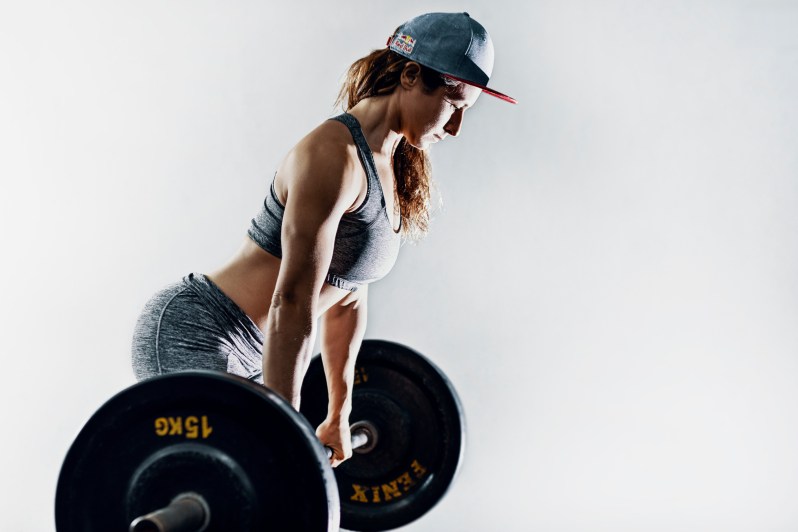
Far from a meathead-specific exercise, you’d be hard-pressed to find a person who does not use (and therefore could not benefit from) the deadlift movement. “It’s ideal for time efficiency, function, caloric expenditure, and, mechanically, everyday life,” says Mike Gattone, Senior Director Sport Performance and Coaching Education for USA Weightlifting. When he’s not advising and training Olympians, Gattone, 56, is passionate about introducing new people to the sport and to weight training in general, and that’s why he’s such a believer in the deadlift. Grabbing the laundry basket from the floor? That’s a deadlift movement. Pick up a niece or nephew? That’s a deadlift movement. Even getting up out of a chair or walking up stairs involves some of its actions. “You want to through your life maintaining the ability to pick up heavier objects off the floor,” he says, “and that’s the beauty of building the deadlift and maintaining or building functionality.” In short, the deadlift is for the everyman and every man.
While the deadlift, when learned correctly, is simple, effective, and safe, there are a few points of caution. A bulging disk 0r other back or orthopedic issue? You may be better of with other leg exercises, and at the very least you should consult with a doctor or physical therapist before jumping in. But for most adults, Gattone says, all it takes is proper technique, attention to form, and the proper sets and reps and you’re off and running.
The Test
Provided you don’t have any pre-existing injuries that would prevent you from deadlifting, the first step is to test yourself for flexibility. “Most adults lack flexibility and mobility in their ankles,” Gattone says, although for most, it won’t effect their deadlift technique. Still, to ensure you’re ready to go, follow this two-part self-evaluation.
Part One
Stand with your feet shoulder-width apart. Now think of having run all-out, that hands-on-your-knees feeling, and push your hips back, until your hands rest on your knees. Keep a straight line from your tailbone through your back to a flat neck, ensuring the spine remains straight. Check your form in a mirror to ensure the position of your back. If there’s no pain or impediment in this range of motion, proceed to Part Two.
Part Two
With your feet just wider than your hips, achieve and hold the flat back and then push your hips back, maintaining your straight spine. When your hands reach approximately knee-height, bend your knees until your fingers touch the ground. Again, is there any pain or impediment in this range of motion? Can you maintain the straightness of your spine throughout? If you’ve answered no to the former and yes to the latter, you’re ready to deadlift.

And Now, the “Railroad” Deadlift
There are two basic deadlifts: the conventional and the sumo. The former involves a shoulder-width stance with the arms outside of the knees. The latter involves a double-width stance, with the arms inside. Gattone recommends a hybrid of these two, which he calls the “railroad stance,” where the feet are a couple of inches wider than shoulder-width on each side, as if you were straddling a railroad track. Your arms, when they grasp the bar, will be inside your knees.
Always start with the full-size plates on the bar if you want to lift from the floor. This means plates the diameter of the 45-pound plate. Specialized lifting plates will all have this diameter, but if your gym doesn’t have these, and alternative is to raise the bar to the approximate height it would have if you did have the 45-pound or lifting plates on. Deadlifting from below this height increases the risk of injury.
With your railroad stance and the bar near your feet, begin to go down the same way you did during your test: With your spine straight from your tailbone to a flat neck, hinge at the hips, throwing them back as your chest lowers. When your hands reach approximately knee-height, bend your knees and lower down until your hands touch the bar.
Next, loosely grasp the bar and roll it until it’s over the intersection where your toes meet your feet. Your arms will be shoulder-width apart, inside but not touching your knees.
Take a full breath and hold it, feeling a 360-degree pressure in your core from your abs to lower back and around the obliques. This is called “packing,” and the inter-abdominal pressure it creates helps protect the spine through the movement.
While holding your breath and maintaining that straight spine, push with your knees until the bar reaches your knee height before thrusting your hips through to complete the movement to standing. Do not flex backward, but rather finish balanced, with the upper body perpendicular to the ground and no further.
With the weight up, exhale. Don’t just drop the weight; instead, inhale and hold, packing the spine, and then reverse the motion, hinging at the hips and lowering the bar as the hips push back. When the bar reaches the knees, bend them and lower the weight the rest of the way to the ground. Exhale and repeat.
Reps, Sets, and Other Miscellany
These are big muscles you’re using in the deadlift, and you’re using a lot of them, so Gattone says the reps aren’t nearly as high as those you’d do for, say, bicep curls. “You don’t have to go super crazy in repetitions,” he says, advising no more 10 reps max in a single set for three or four sets, with a few minutes’ rest in between each set. These take longer to perform well, and if you’re just looking for a 20-minute workout, you should look elsewhere. The goal is quality weight and perfect form rather than trying to achieve an aerobic benefit as you might in a HIIT workout.
Feeding into that, Gattone also recommends not being afraid of the beef. “Put some weight on there,” he says, suggesting super heavy sets of as low as three reps. “Not everyone’s a competitive weightlifter, but you never know what kind of load you’re going to have to lift up off the floor.”





